Drinks, cocktails and massage. Modigliani and Picasso hang on the walls, other men are not allowed here. Master Antoine's living room is a paradise for every woman… until she blows out the door with a bang. How to survive a visit to a capricious genius?
In the 1920s and 1930s, when the king of hairdressers Antoine de Paris was most successful, every woman dreamed of him combing her hair at least once. However, visiting Antoine's salon required certain rules to be followed. His kingdom was ruled by his wife, Marie-Berthe, who made sure that the clients left satisfied and returned as soon as possible. But the most important was Antoine and he dictated the conditions under which his salons operated. His decisions were not discussed.
1. Hygiene
It was the true obsession of the king of hairdressers. He was the first to wash women's hair before cutting and brushing. Dirty, sticky with pomades and repulsing with their rancid scent, the shaggy hair filled him with disgust so he refused to deal with clients who wouldn't wash their heads.
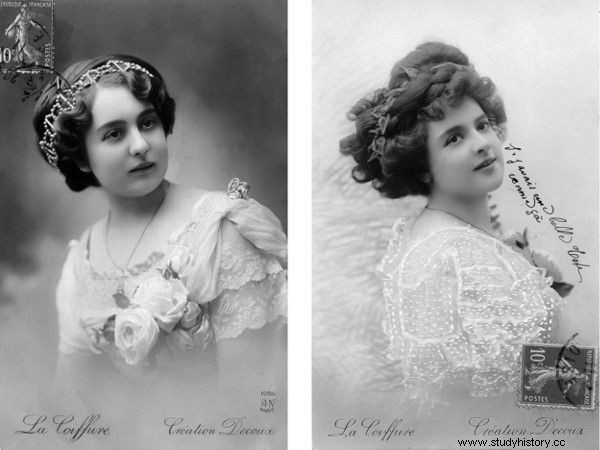
Female hairstyles before the Antoine era:Carefully styled, but dirty hair (photo from the author's archive).
In his first salon, the master installed a fountain-like hair-washing station. He turned this simple activity into a real care ritual and constantly invented new strengthening treatments. Soon the women liked Antoine's fountain so much that they rushed into the living room only to use it.
2. Punctuality
Antoine respected the time of others and demanded respect for his working time. There was no question of being late. Exceeding the set time even by one minute resulted in sending the lady to the end of the queue, and in extreme cases canceling the visit. Senator Maginot said Antoine was the only man the women were not late to meet.
3. Subordination
In the living room, it was Antoine who decided. Always. He patiently listened to what the client had to say, then did what he thought was best for her. He tried to gently convince the hesitant lady of his vision, but when she tried to resist, she might end up outside the door with no way to return. He argued that just as Picasso is not dictated how to paint, no one has the right to tell him how to cut and comb.
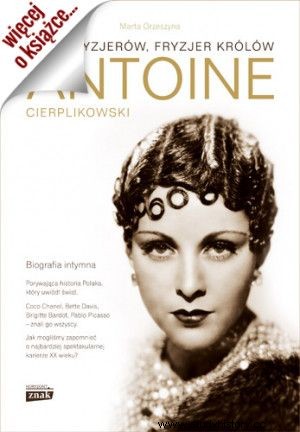
The article is based on the literature and materials collected by the author during the work on the book "Antoine Cierplikowski. The king of hairdressers, the hairdresser of kings ”(Znak Horyzont 2015).
Antoine considered himself an artist and hated cranky clients. He could openly tell a woman that only he could make her beautiful, or he would definitely refuse to perform a service he did not accept. He also came up with the idea of filming clients before and after the transition, which allowed them to fully appreciate his work. There were legends in Paris about the amazing metamorphoses he made ...
4. A wealthy wallet
Since he valued his time and talent, he didn't sell them cheaply. A visit to Antoine cost a lot of money, but there was never a shortage of volunteers. The ladies were ready to pay any sum for his services. He himself was a staunch opponent of promotions and discounts. Working for nothing was unthinkable and never appreciated. All clients, even the most privileged ones, had to pay.
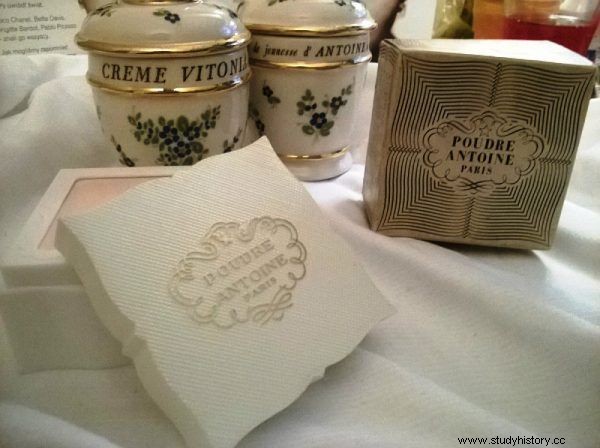
Cosmetics from Antoine's factory were to be no less luxurious than his salons (photo M. Orzeszyn).
In addition to hairdressing services, Antoine's salons offered comprehensive cosmetic services. The customers could buy beauty products from the master's factory and the lifestyle magazine "Antoine. Document pour la femme moderne ”. As the famous hairdresser supported talented artists, the walls of his salon were decorated with paintings by Picasso and Modigliani, which wealthy clients could also buy.
5. Free time
It was best to schedule an entire day to visit Antoine. The meeting with the master had to take a while. The washing itself was a real ceremony, carefully supervised by Mrs. Cierplikowska, especially when it came to the famous egg-rum treatment, requiring practice and patience.
If the employee made a mistake, the whole ritual was started anew. Then Antoine showed up to find the right hairstyle, and that could take even longer. He looked at the lady from all sides, assessed the shape of her head, the color of her eyes and the shade of her skin, and decided how she should be cut and combed.
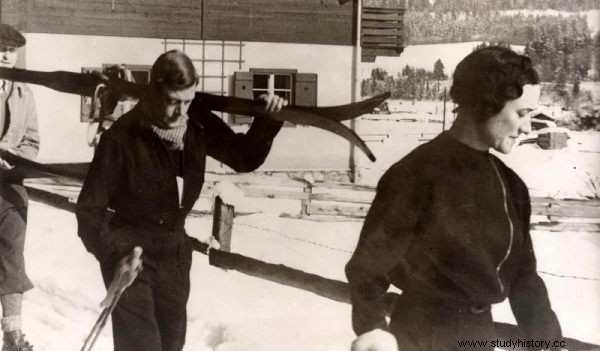
The Prince of Wales's chosen one could not show up on skis in a hairstyle other than that made by Antoine (photo:public domain).
The clients were looked after with care, offering manicures, pedicures, massages, skin care and makeup. They were served hot and cold drinks, cocktails and drinks and when one got hungry, a meal was ordered in one of the nearby exclusive restaurants. At Antoine's place, everything was done to make the woman happy, so it was worth taking a spare time and letting yourself be happy.
6. Tolerance
In Antoine's salon, fashionable people, intellectuals, aristocrats, actresses, artists and ladies from the underworld met. Sometimes even wives with lovers. They all had to leave their prejudices and animosities behind. At Antoine's, they sat together in one spacious room, where they could talk to each other while washing, cutting and brushing.
A place where women could feel at ease and comfortable had to be free from an atmosphere of resentment or hostility. Even fierce rivals had buried their war ax here. Each client, after entering the salon, wore a blue peignoir so that none of them would stand out with their outfits and show off their wealth. Before the hairdresser king, all women were created equal.

The article is based on the literature and materials collected by the author during the work on the book "Antoine Cierplikowski. The king of hairdressers, the hairdresser of kings ”(Znak Horyzont 2015).
7. Personal culture
Antoine hated the lack of class in women. He always put them on a pedestal, respected and was sensitive to their beauty, but if even the most beautiful of them could not behave, all she could do was kiss the door handle of his living room. The lady could not act like a cook, because in a truly beautiful woman beauty should be in harmony with character traits.
8. No gossiping
The staff was forbidden to socialize with clients, and was also required to be completely discreet. What was said with Antoine stayed with Antoine. This rule also applied to clients, because their favorite hairdresser hated gossip, and even more disliked when the salon's matters were discussed in a public forum. Those who could not restrain themselves and keep their mouths shut were in danger of disgrace and even banishment. The vision of losing the pleasure of being with Antoine was so terrifying that the ladies were silent.
9. The men were waiting outside
Even the Duke of Windsor, who willingly accompanied his chosen one and then his wife, could not go inside to watch Antoine's work. The one who gave the throne for love patiently waited in the beautiful garden of the Cannes salon until Wallis was ready. Sometimes it took a long time because the duchess and the hairdresser were good friends and could talk for hours about fashion and art.
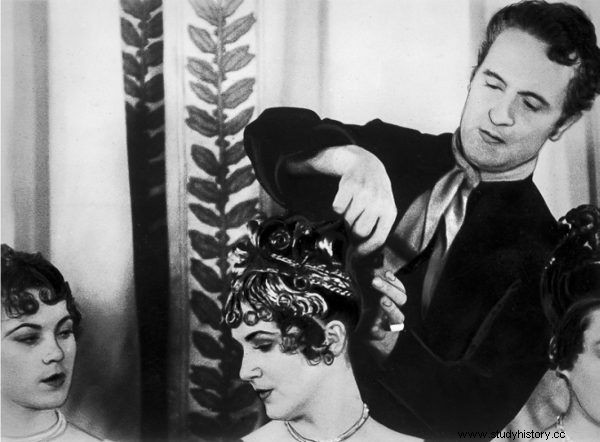
Master at work (photo:National Digital Archives, public domain).
Wealthy gentlemen would often bring their keepers to rue Cambon 5 in Paris to give Antoine a touch of elegance and sophistication to the young girls. However, they had no influence what was going on outside the salon door. Sometimes they only managed to whisper in the master's ear: "Do something to her hair similar to what you recently did to my wife."
10. Fame above money
Antoine's clients were women who were fabulously rich and very famous. The Master had a distinct weakness for the latter. He would ditch a fortune-teller to take care of the one everyone was talking about. The king of hairdressers knew very well that all Paris would be discussing this famous hairstyle in a moment, and he valued nothing more than whispered advertising. He already had enough money to afford to take it lightly.
***
Women who were lucky enough to be Antoine's clients spoke very highly of him. They valued him and were grateful to him for the gift of beautification. For many, he was the man who brought out their true personality.
Source:
You can read more about the king of hairdressers, his career and personal life in Marta Orzeszyna's book entitled "Antoine Cierplikowski. The king of hairdressers, the hairdresser of kings ”(Znak Horyzont 2015). The article is based on the literature and materials collected by the author during the work on the book. As a reader of Historical Curiosities, you can buy it at a 30% discount!
Editing:Roman Sidorski, photo edition:Roman Sidorski
